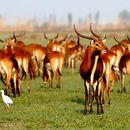Biology
provided by Arkive
Black lechwe are found in large, loose herds in which no strict social system exists (2). Males tend to congregate on drier land than the females (2). Lechwe are at ease in water and may often be seen wading shoulder high in order to graze on the most nutritious plants (2). Mating occurs in the rainy season between November and February and males compete for access to females by forming what is known as a 'lekking system' (5). Males hold small areas (known as 'leks') within a common arena, and fight to hold prime locations in the centre of the group where there is greater access to females (2). A single young is born after a seven or eight month gestation period and is initially left in concealed areas on dry land while their mother feeds; she returns periodically to suckle her young (6).
The floodplain soil is highly fertile and nutritious grasses make up the majority of the lechwe diet. Herds will follow the seasonal floods, taking refuge in wooded areas if flooding is extreme (6). On land, these antelope appear slow and clumsy but they are able to out-run predators in the water thanks to their large, powerful hind legs which propel them in long leaps (5).
Conservation
provided by Arkive
Information not available at present.
Description
provided by Arkive
The black lechwe is one of three living subspecies of the lechwe, a water antelope of southern Africa (4). The long body is highest at the hindquarters and the hooves are elongated and spreading, which prevent the lechwe from sinking into the marshy ground of its habitat (5). Males possess long, thin lyre-shaped horns that are highly ridged (4). Lechwe have a long, greasy coat that differs in colour between the subspecies; the coast of K. l. smithemani is black, as the common name suggests (2).
Habitat
provided by Arkive
Lechwe inhabit floodplains, bordering swamps (6).
Range
provided by Arkive
Found in Zambia, southern Africa. The majority of the population occurs at Lake Bangweulu (5).
Status
provided by Arkive
Classified as Vulnerable (VU) by the IUCN Red List 2002 (1). Listed (at species level) on Appendix II of CITES (3).
Threats
provided by Arkive
Hunting and the construction of hydroelectric dams, which eliminate floodplain habitat by altering river systems, are the major threats to the survival of this aquatic antelope (2).

